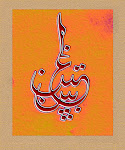Is a technique in which paint is applied to a water covered surface to produce a design. Its very popular in Turkey and is often found with the opening of the Koran "Bismallah" or with a tulip motif.

Although it is not known with certainty when the art of creating designs on water originated, it does date back as far as the 8th-9th centuries. The Turks took up the art of marbling in Turkestan in the 15th century and brought it with them across Iran to Anatolia via the Silk Road. The word 'ebre' in the Chaghatay language of Turkestan means 'veined or water-marked'. In Persian, the word 'abru' means 'water surface', while 'ebri' has the meaning 'cloudy'. In the dictionary of the Turkish Linguistic Society, the word 'ebru' is defined as “a sort of water paper on which decorators produce designs in a variety of colors.”
The materials used in ebru include the basin that contains the water, the substances used as thickening agents (gum tragacanth, carrageen, sahlep root), ox bile, the dyes, which are oil-based and not water soluble, the brushes, and the needles of varying degrees of thickness




